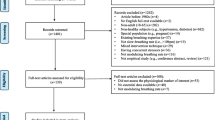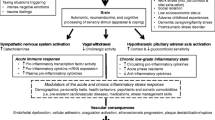Abstract
The purpose of this study is to study the effect of age on the correlation between heart rate variability (HRV) and blood pressure variability (BPV). To meet this end, multi-scale cross correlation (CC) analysis of HRV and systolic blood pressure variability (SBPV) was performed. The Approximate Entropy (ApEn) and Recurrence Quantification Analysis (RQA) derived indices, calculated from RR interval series (RRi) and systolic blood pressure (SBP) series at multiple temporal scales, are the basis of this CC analysis. For the computation of ApEn and RQA indices, the tolerance threshold (r) is chosen by either: (i) selecting any arbitrary value (0.2) within the recommended range (0.1–0.25) times standard deviation (SD) of time series, and (ii) taking the ‘r’ (ropt) corresponding to maximum ApEn (ApEnmax) as tolerance threshold. It is found that (i) at each time scale (τ), a lower SD is observed when indices are computed using ropt than \(\text{r}=0.2\times \text{SD}\) (r0.2), for RRi as well as SBP series, (ii) descriptive indices of RRi are found significant (p < 0.05) at all scales (τ), however for SBP, these are found insignificant (p > 0.05) at most of the scales, (iii) CC values of descriptive statistics viz., mean and SD are not significant (p > 0.05) irrespective of τ, barring τ = 1, (iv) CC values of ApEn and RQA indices, found using ropt, are found significant (p < 0.05) and provide enhanced stratification at τ = 1, 2 and 3, whereas this significant correlation and strong classification is missing for indices calculated using r0.2, and (v) Lastly as τ increases, ApEn and RQA indices, computed with ropt, reverse their trend but manage to provide significant difference in elder and younger subjects. It is concluded that HRV and SBPV interactions gets altered with age. Descriptive indicators however are not enough to capture these changes. These complex interactions can only be deciphered using complexity-based methods such as approximate entropy and that too at the multiple scale level.






Similar content being viewed by others
References
Costa M, Goldberger AL, Peng CK (2005) Multiscale entropy analysis of biological signals. Phys Rev E Stat Nonlinear Soft Matter Phys 71:1–18. https://doi.org/10.1103/PhysRevE.71.021906
Shiogai Y, Stefanovska A, McClintock PVEE (2010) Nonlinear dynamics of cardiovascular ageing. Phys Rep 488:51–110. https://doi.org/10.1016/j.physrep.2009.12.003
Mao X, Shang P (2018) A new method for tolerance estimation of multivariate multiscale sample entropy and its application for short-term time series. Nonlinear Dyn 94:1793–1752. https://doi.org/10.1007/s11071-018-4453-1
Singh A, Saini BS, Singh D (2015) Multiscale joint symbolic transfer entropy for quantification of causal interactions between heart rate and blood pressure variability under postural stress. Fluct Noise Lett 14:1550031. https://doi.org/10.1142/S0219477515500315
Schinkel S, Dimigen O, Marwan N (2008) Selection of recurrence threshold for signal detection. Eur Phys J Spec Top 164:45–53. https://doi.org/10.1140/epjst/e2008-00833-5
Krstacic G, Parati G, Gamberger D et al (2012) Heart rate variability and nonlinear dynamic analysis in patients with stress-induced cardiomyopathy. Med Biol Eng Comput 50:1037–1046. https://doi.org/10.1007/s11517-012-0947-z
Acharya UR, Joseph KP, Kannathal N et al (2006) Heart rate variability: a review. Med Biol Eng Comput 44:1031–1051. https://doi.org/10.1007/s11517-006-0119-0
Castiglioni P, Di Rienzo M (2008) How the threshold “r” influences approximate entropy analysis of heart-rate variability. Comput Cardiol 35:561–564. https://doi.org/10.1109/CIC.2008.4749103
Huikuri HV, Mäkikallio TH, Perkiömäki J (2003) Measurement of heart rate variability by methods based on nonlinear dynamics. J Electrocardiol 36:95–99. https://doi.org/10.1016/j.jelectrocard.2003.09.021
Richman JS, Lake DE, Moorman JR (2004) Sample entropy. Methods Enzymol 384:172–184. https://doi.org/10.1016/S0076-6879(04)84011-4
Marwaha P, Sunkaria RK (2017) Exploring total cardiac variability in healthy and pathophysiological subjects using improved refined multiscale entropy. Med Biol Eng Comput 55:191–205. https://doi.org/10.1007/s11517-016-1476-y
Lee J, Nemati S, Silva I et al (2012) Transfer entropy estimation and directional coupling change detection in biomedical time series. Biomed Eng Online 11:19. https://doi.org/10.1186/1475-925X-11-19
Rawal K, Saini BS, Saini I (2015) Adaptive correlation dimension method for analysing heart rate variability during the menstrual cycle. Australas Phys Eng Sci Med 38:509–523. https://doi.org/10.1007/s13246-015-0369-y
Arcentales A, Giraldo BF, Caminal P et al (2011) Recurrence quantification analysis of heart rate variability and respiratory flow series in patients on weaning trials. Annu Int Conf IEEE Eng Med Biol Soc 2011:2724–2727. https://doi.org/10.1109/IEMBS.2011.6090747
García-González MA, Fernández-Chimeno M, Ramos-Castro J (2009) Errors in the estimation of approximate entropy and other recurrence-plot-derived indices due to the finite resolution of RR time series. IEEE Trans Biomed Eng 56:345–351. https://doi.org/10.1109/TBME.2008.2005951
Giera J, Hoyer D, Tetschke F et al (2013) Development of multiscale complexity and multifractality of fetal heart rate variability. Auton Neurosci Basic Clin 178:29–36. https://doi.org/10.1016/j.autneu.2013.01.009
Fischer R, Akay M, Castiglioni P, Di Rienzo M (2003) Multi- and monofractal indices of short-term heart rate variability. Med Biol Eng Comput 41:543–549
Roy M (2014) Study the effect of music on HRV impulse using multifractal DF A analysis. In: IEEE International Conference on Communication and Signal Processing, pp 1338–1342
Castiglioni P, Lazzeroni D, Coruzzi P, Faini A (2018) Multifractal-multiscale analysis of cardiovascular signals: a dfa-based characterization of blood pressure and heart-rate complexity by gender. Complexity 2018: 4801924. doi: https://doi.org/10.1155/2018/4801924. Complexity 2018. doi: https://doi.org/10.1155/2018/5426860
Hu J, Gao J, Tung W et al (2009) Characterizing heart rate variability by scale-dependent Lyapunov exponent . Chaos An Interdiscip J Nonlinear Sci 19:028506. https://doi.org/10.1063/1.3152007
Costa M, Goldberger AL, Peng C (2002) Multiscale entropy analysis of complex physiologic time series. Phys Rev Letters 89:068102. https://doi.org/10.1103/PhysRevLett.89.068102
Singh A, Saini BS, Singh D (2016) An adaptive technique for multiscale approximate entropy (MAEbin) threshold (r) selection: application to heart rate variability (HRV) and systolic blood pressure variability (SBPV) under postural stress. Australas Phys Eng Sci Med 39:557–569. https://doi.org/10.1007/s13246-016-0432-3
Trunkvalterova Z, Javorka M, Tonhajzerova I et al (2008) Reduced short-term complexity of heart rate and blood pressure dynamics in patients with diabetes mellitus type 1: multiscale entropy analysis. Physiol Meas 29:817–828. https://doi.org/10.1088/0967-3334/29/7/010
Pan W-Y, Su M-C, Wu H-T et al (2015) Multiscale entropy analysis of heart rate variability for assessing the severity of sleep disordered breathing. Entropy 17:231–243. https://doi.org/10.3390/e17010231
Pincus SM (1991) Approximate entropy as a measure of system complexity. Proc Natl Acad Sci 88:2297–2301. https://doi.org/10.1073/pnas.88.6.2297
Chon K, Scully C, Lu S (2009) Approximate entropy for all signals. IEEE Eng Med Biol Mag 28:18–23. https://doi.org/10.1109/MEMB.2009.934629
Singh A, Saini BS, Singh D (2016) An alternative approach to approximate entropy threshold value (r) selection: application to heart rate variability and systolic blood pressure variability under postural challenge. Med Biol Eng Comput 54:723–732. https://doi.org/10.1007/s11517-015-1362-z
Reulecke S, Charleston Villalobos S, Voss A et al (2017) Temporal analysis of cardiovascular and respiratory complexity by multiscale entropy based on symbolic dynamics. IEEE J Biomed Heal Informatics 2194:1–1. https://doi.org/10.1109/JBHI.2017.2761354
Ding H, Crozier S, Wilson S (2007) A new heart rate variability analysis method by means of quantifying the variation of nonlinear dynamic patterns. IEEE Trans Biomed Eng 54:1590–1597. https://doi.org/10.1109/TBME.2007.893495
Manikandan MS, Soman KP (2012) A novel method for detecting R-peaks in electrocardiogram (ECG) signal. Biomed Signal Process Control 7:118–128. https://doi.org/10.1016/j.bspc.2011.03.004
Webber CL, Zbilut JP (2005) Recurrence quantification analysis of nonlinear dynamical systems. In: Tutorials in contemporary nonlinear methods for the behavioral sciences, pp 26–94
Webber CL, Marwan N (2015) Recurrence quantification analysis theory and best practices, 1st edn. Springer International Publishing, Cham, Switzerland
Lu S, Chen X, Kanters JK et al (2008) Automatic selection of the threshold value r for approximate entropy. IEEE Trans Biomed Eng 55:1966–1972. https://doi.org/10.1109/TBME.2008.919870
Singh B, Singh D (2012) Effect of threshold value r on multiscale entropy based heart rate variability. Cardiovasc Eng Technol 3:211–216. https://doi.org/10.1007/s13239-012-0082-x
Singh V, Gupta A, Sohal JS, Singh A (2018) A unified non-linear approach based on recurrence quantification analysis and approximate entropy: application to the classification of heart rate variability of age-stratified subjects. Med Biol Eng Comput 57:741–755. https://doi.org/10.1007/s11517-018-1914-0
Porta A, Castiglioni P, Di Rienzo M et al (2012) Short-term complexity indexes of heart period and systolic arterial pressure variabilities provide complementary information. J Appl Physiol 113:1810–1820. https://doi.org/10.1152/japplphysiol.00755.2012
Udhayakumar RK, Karmakar C, Palaniswami M (2017) Approximate entropy profile: a novel approach to comprehend irregularity of short-term HRV signal. Nonlinear Dyn 88:823–837. https://doi.org/10.1007/s11071-016-3278-z
Li X, Yu S, Chen H et al (2015) Cardiovascular autonomic function analysis using approximate entropy from 24-h heart rate variability and its frequency components in patients with type 2 diabetes. J Diabetes Investig 6:227–235. https://doi.org/10.1111/jdi.12270
Porta A, Bari V, Ranuzzi G et al (2017) Assessing multiscale complexity of short heart rate variability series through a model- based. Chaos An Interdiscip J Nonlinear Sci 27:093901. https://doi.org/10.1063/1.4999353
Beckers F (2006) Aging and nonlinear heart rate control in a healthy population. AJP Hear Circ Physiol 290:H2560–H2570. https://doi.org/10.1152/ajpheart.00903.2005
Angelini L, Maestri R, Marinazzo D et al (2007) Multiscale analysis of short term heart beat interval, arterial blood pressure, and instantaneous lung volume time series. Artif Intell Med 41:237–250. https://doi.org/10.1016/j.artmed.2007.07.012
Kaplan DT, Furman MI, Pincus SM et al (1991) Aging and the complexity of cardiovascular dynamics. Biophys J 59:945–949. https://doi.org/10.1016/S0006-3495(91)82309-8
Author information
Authors and Affiliations
Corresponding author
Ethics declarations
Ethical approval
All procedures performed in studies involving human participants were in accordance with the ethical standards of the institutional research advisory committee and with the 1964 Helsinki declaration and its later amendments or comparable ethical standards. Informed consent was taken from all the participating subjects.
Additional information
Publisher's Note
Springer Nature remains neutral with regard to jurisdictional claims in published maps and institutional affiliations.
Rights and permissions
About this article
Cite this article
Singh, V., Gupta, A., Sohal, J.S. et al. Age induced interactions between heart rate variability and systolic blood pressure variability using approximate entropy and recurrence quantification analysis: a multiscale cross correlation analysis. Phys Eng Sci Med 44, 497–510 (2021). https://doi.org/10.1007/s13246-021-01000-7
Received:
Accepted:
Published:
Issue Date:
DOI: https://doi.org/10.1007/s13246-021-01000-7




